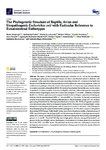The Phylogenetic Structure of Reptile, Avian and Uropathogenic Escherichia coli with Particular Reference to Extraintestinal Pathotypes
| dc.contributor.author | Książczyk, M | |
| dc.contributor.author | Dudek, B | |
| dc.contributor.author | Kuczkowski, M | |
| dc.contributor.author | O’Hara, R | |
| dc.contributor.author | Korzekwa, K | |
| dc.contributor.author | Wzorek, A | |
| dc.contributor.author | Korzeniowska-Kowal, A | |
| dc.contributor.author | Upton, Mathew | |
| dc.contributor.author | Junka, A | |
| dc.contributor.author | Wieliczko, A | |
| dc.contributor.author | Ratajszczak, R | |
| dc.contributor.author | Bugla-Płoskońska, G | |
| dc.date.accessioned | 2021-02-15T18:02:13Z | |
| dc.date.issued | 2021-01-26 | |
| dc.identifier.issn | 1422-0067 | |
| dc.identifier.issn | 1422-0067 | |
| dc.identifier.other | ARTN 1192 | |
| dc.identifier.uri | http://hdl.handle.net/10026.1/16883 | |
| dc.description.abstract |
<jats:p>The impact of the Gram-negative bacterium Escherichia coli (E. coli) on the microbiomic and pathogenic phenomena occurring in humans and other warm-blooded animals is relatively well-recognized. At the same time, there are scant data concerning the role of E. coli strains in the health and disease of cold-blooded animals. It is presently known that reptiles are common asymptomatic carriers of another human pathogen, Salmonella, which, when transferred to humans, may cause a disease referred to as reptile-associated salmonellosis (RAS). We therefore hypothesized that reptiles may also be carriers of specific E. coli strains (reptilian Escherichia coli, RepEC) which may differ in their genetic composition from the human uropathogenic strain (UPEC) and avian pathogenic E. coli (APEC). Therefore, we isolated RepECs (n = 24) from reptile feces and compared isolated strains’ pathogenic potentials and phylogenic relations with the aforementioned UPEC (n = 24) and APEC (n = 24) strains. To this end, we conducted an array of molecular analyses, including determination of the phylogenetic groups of E. coli, virulence genotyping, Pulsed-Field Gel Electrophoresis-Restriction Analysis (RA-PFGE) and genetic population structure analysis using Multi-Locus Sequence Typing (MLST). The majority of the tested RepEC strains belonged to nonpathogenic phylogroups, with an important exception of one strain, which belonged to the pathogenic group B2, typical of extraintestinal pathogenic E. coli. This strain was part of the globally disseminated ST131 lineage. Unlike RepEC strains and in line with previous studies, a high percentage of UPEC strains belonged to the phylogroup B2, and the percentage distribution of phylogroups among the tested APEC strains was relatively homogenous, with most coming from the following nonpathogenic groups: C, A and B1. The RA-PFGE displayed a high genetic diversity among all the tested E. coli groups. In the case of RepEC strains, the frequency of occurrence of virulence genes (VGs) was lower than in the UPEC and APEC strains. The presented study is one of the first attempting to compare the phylogenetic structures of E. coli populations isolated from three groups of vertebrates: reptiles, birds and mammals (humans).</jats:p> | |
| dc.format.extent | 1192-1192 | |
| dc.format.medium | Electronic | |
| dc.language | en | |
| dc.language.iso | en | |
| dc.publisher | MDPI AG | |
| dc.rights | Attribution-NonCommercial-NoDerivatives 4.0 International | |
| dc.rights | Attribution-NonCommercial-NoDerivatives 4.0 International | |
| dc.rights | Attribution-NonCommercial-NoDerivatives 4.0 International | |
| dc.rights | Attribution-NonCommercial-NoDerivatives 4.0 International | |
| dc.rights | Attribution-NonCommercial-NoDerivatives 4.0 International | |
| dc.rights.uri | http://creativecommons.org/licenses/by-nc-nd/4.0/ | |
| dc.rights.uri | http://creativecommons.org/licenses/by-nc-nd/4.0/ | |
| dc.rights.uri | http://creativecommons.org/licenses/by-nc-nd/4.0/ | |
| dc.rights.uri | http://creativecommons.org/licenses/by-nc-nd/4.0/ | |
| dc.rights.uri | http://creativecommons.org/licenses/by-nc-nd/4.0/ | |
| dc.subject | extraintestinal E | |
| dc.subject | coli | |
| dc.subject | phylogenetic analysis | |
| dc.subject | virulence genes | |
| dc.title | The Phylogenetic Structure of Reptile, Avian and Uropathogenic Escherichia coli with Particular Reference to Extraintestinal Pathotypes | |
| dc.type | journal-article | |
| dc.type | Journal Article | |
| plymouth.author-url | https://www.webofscience.com/api/gateway?GWVersion=2&SrcApp=PARTNER_APP&SrcAuth=LinksAMR&KeyUT=WOS:000615295800001&DestLinkType=FullRecord&DestApp=ALL_WOS&UsrCustomerID=11bb513d99f797142bcfeffcc58ea008 | |
| plymouth.issue | 3 | |
| plymouth.volume | 22 | |
| plymouth.publication-status | Published online | |
| plymouth.journal | International Journal of Molecular Sciences | |
| dc.identifier.doi | 10.3390/ijms22031192 | |
| plymouth.organisational-group | /Plymouth | |
| plymouth.organisational-group | /Plymouth/Faculty of Health | |
| plymouth.organisational-group | /Plymouth/Faculty of Health/School of Biomedical Sciences | |
| plymouth.organisational-group | /Plymouth/REF 2021 Researchers by UoA | |
| plymouth.organisational-group | /Plymouth/REF 2021 Researchers by UoA/UoA01 Clinical Medicine | |
| plymouth.organisational-group | /Plymouth/Research Groups | |
| plymouth.organisational-group | /Plymouth/Research Groups/Institute of Translational and Stratified Medicine (ITSMED) | |
| plymouth.organisational-group | /Plymouth/Research Groups/Institute of Translational and Stratified Medicine (ITSMED)/CBR | |
| plymouth.organisational-group | /Plymouth/Research Groups/Plymouth Institute of Health and Care Research (PIHR) | |
| plymouth.organisational-group | /Plymouth/Users by role | |
| plymouth.organisational-group | /Plymouth/Users by role/Academics | |
| plymouth.organisational-group | /Plymouth/Users by role/Researchers in ResearchFish submission | |
| dc.publisher.place | Switzerland | |
| dcterms.dateAccepted | 2020-12-18 | |
| dc.rights.embargodate | 2021-3-20 | |
| dc.identifier.eissn | 1422-0067 | |
| dc.rights.embargoperiod | Not known | |
| rioxxterms.versionofrecord | 10.3390/ijms22031192 | |
| rioxxterms.licenseref.uri | http://creativecommons.org/licenses/by-nc-nd/4.0/ | |
| rioxxterms.licenseref.startdate | 2021-01-26 | |
| rioxxterms.type | Journal Article/Review |



